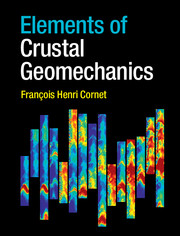Book contents
- Frontmatter
- Epigraph
- Contents
- Preface
- 1 Geomaterials and crustal geomechanics
- 2 Elements of rheology
- 3 Forces and stresses
- 4 Elements of kinematics
- 5 Elements of linear elasticity
- 6 From continuum mechanics to fluid mechanics
- 7 Elements of linear fracture mechanics
- 8 Laboratory investigations on geomaterials under compression 183
- 9 Homogenized geomaterials
- 10 Fractures and faults
- 11 Elements of seismology
- 12 Elements of solid–fluid interactions
- 13 Methods for stress field evaluation from in situ observations
- 14 Elements of stress fields and crustal rheology
- Appendix Elements of tensors in rectangular coordinates
- References
- Index
10 - Fractures and faults
Published online by Cambridge University Press: 05 April 2015
- Frontmatter
- Epigraph
- Contents
- Preface
- 1 Geomaterials and crustal geomechanics
- 2 Elements of rheology
- 3 Forces and stresses
- 4 Elements of kinematics
- 5 Elements of linear elasticity
- 6 From continuum mechanics to fluid mechanics
- 7 Elements of linear fracture mechanics
- 8 Laboratory investigations on geomaterials under compression 183
- 9 Homogenized geomaterials
- 10 Fractures and faults
- 11 Elements of seismology
- 12 Elements of solid–fluid interactions
- 13 Methods for stress field evaluation from in situ observations
- 14 Elements of stress fields and crustal rheology
- Appendix Elements of tensors in rectangular coordinates
- References
- Index
Summary
The concept of fracture discussed in this chapter applies to structures for which the dimension in one direction is three to six orders of magnitudes smaller than the dimensions in the two perpendicular directions. These structures are often referred to as joints, in the rock mechanics literature. In the geological literature, however, joints refer sometimes only to mode I fractures (no tangential displacement has occurred along the fracture). The word “fracture”, as used below, does not imply any restriction on the direction of relative displacements that occur across these surfaces of discontinuity.
Fractures are assimilated to sub-planar structures, which include solid bridges together with the interconnected pore space in between the bridges (see section 1.3.1). Generally fractures involve both solid and fluid phases and here these phases are assumed not to interact except through the effective stress concept already introduced (section 8.1.6). Issues relating to solid-fluid interactions are discussed in chapter 12.
We will separate, in a somewhat artificial manner, the concept of fracture from that of microcracks. Microcracks never exceed a few centimeters and are dealt with implicitly through the definition of the appropriate mechanical or hydraulic characteristics for an equivalent continuous geomaterial (chapter 9). In chapter 7, on fracture mechanics, we outlined the influence of microcracks as local sources of stress concentration. But we emphasize that microcracks are not fractures: they remain of microscopic scale, with simple geometry. Sometimes their surface is assumed to be stress free (Kachanov et al., 2010). Fractures are always larger than the decimeter scale, so their roughness cannot be ignored. They are dealt with explicitly through their mechanical and hydraulic characteristics. Furthermore, attention must be given not only to the individual fracture properties but also to the corresponding fracture network characteristics (see the discussion of fracture fields in section 1.3.3). In this chapter we consider only quasistatic loading processes. Dynamic issues are discussed in chapters 7, 11 and 12.
- Type
- Chapter
- Information
- Elements of Crustal Geomechanics , pp. 253 - 282Publisher: Cambridge University PressPrint publication year: 2015



